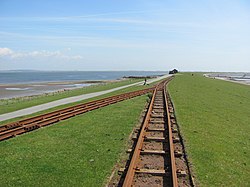






A railway zig zag or switchback is a railway operation in which a train is required to switch its direction of travel to continue its journey. While this may be required purely from an operational standpoint, it is also ideal for climbing steep gradients with minimal need for tunnels and heavy earthworks. [1] For a short distance (corresponding to the middle leg of the letter "Z"), the direction of travel is reversed, before the original direction is resumed. [2] Some switchbacks do not come in pairs, and the train may then need to travel backwards for a considerable distance.
Contents
A location on railways constructed by using a zig-zag alignment at which trains must reverse direction to continue is a reversing station. [3]
One of the best-known examples is the Darjeeling Himalayan Railway, a UNESCO World Heritage Site railway in India, which has six full zig zags and three spirals. [4]